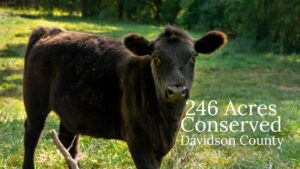
by Taylor Minich
July 7, 2017

Crystal Cockman and I had the pleasure of joining Kacy Cook, a land conservation biologist for the North Carolina Wildlife Resource Commission, last week as she surveyed bird populations around Stanly County. Kacy’s work will add to the already extensive data collected since 2008, monitoring population trends among grassland bird species. As many of these species are declining, bird surveying is an invaluable tool for conservation biologists and environmental managers to find and combat the proximate causes for this reduction. And, it’s a nice way to spend the day.
Hitting the road around five o’clock in the morning with the sun’s pink rays just barely lighting the dewy fields, Kacy takes us along for the ride. Literally. We drive to the first waypoint on the list—an unassuming white ribbon tied to a dilapidated wooden fence. Kacy marks all of the points along her route this way although some of the other ribbons don’t stand the test of time so well.
We park on the side of the road, and step into the crisp air. Kacy grabs her clipboard and pen, sets her timer to three minutes, and hits START. Curving her hands around her ears, she listens to the euphony of birds around us.
“You hear that? The noise that sounds like a cricket? Well, it’s actually a grasshopper sparrow – one of our priority species.”
After listening to the buzzing, I politely nod, not entirely confident in my ability to distinguish that bird’s song from an actual grasshopper beating its legs. She marks the sparrow’s location on her collection sheet. Although Kacy can recognize most of the birds in the area, she’s best at identifying the survey’s priority species, those with dwindling populations.
“And that’s an eastern meadowlark! Hear how it dips at the end?”
Raising a pair of binoculars to my eyes, I search for the sources of these calls. No luck. Birding is best done by ear.
A shrill beep drowns out the birdcalls. It’s time for us to move on.
We continue this way for hours, winding from waypoint to waypoint along gravel roads through fields of corn, soy, and wheat, pastures, and prairies, periodically stopping two dozen times for Kacy to fill out more surveys and for us to learn more calls. Bobwhite quail, orchard oriole, prairie warbler, Eastern kingbird, and the elusive mockingbird are just a handful of the birds we saw and heard that day. None, though, was as exciting as the loggerhead shrike.
What loggerhead shrikes lack in size they make up for in reputation. Infamous for the way they impale their prey on thorns and even barbed wire, these birds wear their black bandit masks with pride. Towards the end of the route, we came across one silently hunting in the field below. The shrike swoops down with a precision as razor-like as its hooked beak. We could just spy its prey, an unsuspecting and unlucky grasshopper, before being eviscerated.
So rare is the loggerhead shrike in North Carolina that we waited for our chance discovery to make its way back to its nest. An hour passed with our binoculared eyes glued to the perched predator, a period of time we affectionately refer to as the Shrikeout, before finally the object of our observation nimbly flew into a broad juniper tree. Kacy takes a picture of the tree and marks its position on her GPS so that she might find the rapacious songbird later on.
The Shrikeout over, we headed home, satisfied by our serendipitous encounter.